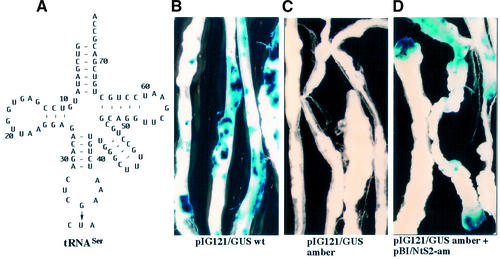Figure 2.
Histochemical analyses of GUS activity in Arabidopsis hypocotyl-derived calli after Agrobacterium-mediated transformation. The agrobacteria contained the vector pIG121/GUS wt, carrying the wildtype gusA gene (B) or the vector pIG121/GUS amber, carrying a mutated gusA gene with a premature amber codon (C) as indicated in Figure 1A or the calli were co-cultivated with two different strains of Agrobacterium, harboring either the pIG121/GUS amber plasmid or a tobacco amber suppressor tRNASer gene (NtS2-am) in the vector pBI (D) as illustrated in Figure 1B. After co-cultivation for 3 days, the explants were washed in liquid MS medium several times in order to remove the bacteria, followed by incubation in X-Gluc-containing phosphate buffer overnight. The samples were decolored with 70% ethanol before the microscopic evaluation. The left panel (A) shows the cloverleaf structure of the amber suppressor tRNASer expressed in the transformed Arabidopsis explants (D). The nucleotide sequence is deduced from NtS2, which contains a Nicotiana tRNASer gene with CGA anticodon. The modified nucleosides of the tRNASer isoacceptor are not indicated and are presented elsewhere (20). A single mutation at position 35 in the anticodon (G→U) converts the tRNASer into an amber suppressor with CUA anticodon.

